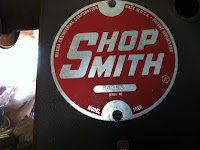
The Shopsmith folks, on the other hand, had a better idea: keep the motor, pulleys/belt, and saw blade fixed...and move the table.

This may seem like a much simpler design, and it probably is, but the table support and tilt system is still a rather complex system. The Shopsmith 10ER table mounts onto a tie bar which in turn sits on top of two vertical rods. The tie bar provides pivot points upon which the table rotates through all degrees, including a full 900 which is required when converting the unit to a vertical drill press configuration.

The height of the table is controlled by a raiser bar attached to one of the vertical rods and a raiser level crank mounted on the carriage. As the crank is turned clockwise or counter clockwise, the table raises and lowers accordingly.
Rusty’s Table
 Enough of Shopsmith 101; let's get back to Rusty’s table. It was, well you guessed it, ...rusty.
Enough of Shopsmith 101; let's get back to Rusty’s table. It was, well you guessed it, ...rusty. 
I disassembled the table parts - which was the easy part (it’s always the easy part!). There are more pieces than one (certainly I) would think. I soaked them in Evapo-Rust overnight and hoped I could remember how to put everything back together. My goal: no left over parts after re-assembly.
I cleaned up the table a little with a simple scrubbing...but I think I can do better.
 And what’s with the insert? It looks like it was made with a chain saw. This simply won’t do....won’t do at all!
And what’s with the insert? It looks like it was made with a chain saw. This simply won’t do....won’t do at all!Thanks to MKCTools.com, I ordered a new set of inserts, including one to fit my DADO set.
The remaining accessories (fence, miter gauge, tailstock, end table, etc) all need some attention.










No comments:
Post a Comment